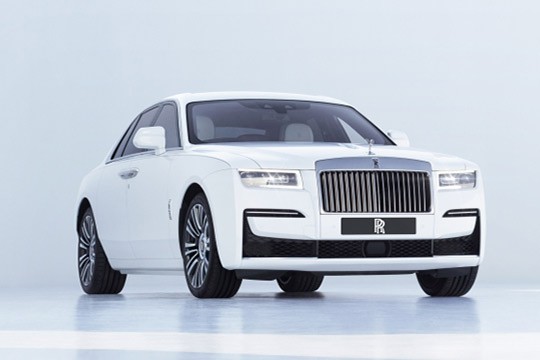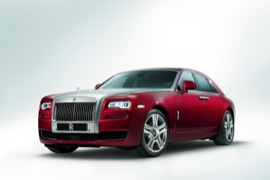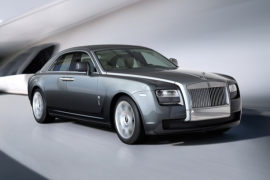ROLLS-ROYCE Ghost Models/Series Timeline, Specifications & Photos
First production year: 2009
Engines: Gasoline
The Rolls-Royce brand always had a specific prestige in the motoring industry and it was always used as a landmark for luxury and opulence. In 2020, the British company introduced the new Ghost.
With over a century in the automotive industry, Rolls-Royce was the Koh-I-Noor of the British automotive industry. It was purchased by BMW in the late '90s and it evolved rapidly from a single model to a wider range. While its flagship was the Phantom, the Ghost was more of an entry-level. A level where other car-makers had to struggle to offer what the Ghost featured as standard.
Rolls-Royce was not concerned about aerodynamic when it was about its cars. The big, massive, front end, with a straight-up and slightly V-shaped radiator grille, was a brand's heritage and it was easy to recognize. It didn't even need a badge for it, but it still had the Spirit of Ecstasy silver statuette on top of the radiator. The LED headlights still kept the same squared shape from the 2009 EX200 concept-car. The minimalist exterior look, with a low profiled greenhouse, made the car looks imposing on the road.
The passenger cabin was a luxurious place with seating for five. The large and thick front seats offered the comfort of a six-figure price car that could go effortlessly for long distances. The new technologies used for the dashboard and infotainment system were well integrated into the classic interior look. Maybe the HVAC controls on the center stack resembled too much those existing in the BMW 7-Series, but other than that it was Rolls-Royce as usual.
The powertrain was developed around the 6.75-liter twin-turbo engine. It sent its power to its all-wheel-drive and all-wheel-steering system. The Ghost used a modified platform version used for the Rolls-Royce Cullinan as well.
After almost five years on the market, Rolls-Royce refreshed the Ghost lineup and named it Ghost II. It was not a common brand to use the mundane words "facelift" or "life-cycle impulse."
The British automaker introduced the refreshed version of the Ghost's first generation in 2014 to make it comply with the Euro 6 emission standards and, at the same time, changed some parts of the vehicle and made it more appealing to its customers. In addition, it made it with an extended wheelbase version that became the most expensive Rolls-Royce manufactured in that year, even though the SWB Ghost was the most affordable from the stable. Moreover, it enhanced the car's look, the interior, the infotainment system, and the drivetrain.
Based on BMW's CLAR architecture, the Ghost II featured a slightly redesigned bodywork with redesigned headlights where the automaker installed uninterrupted daytime running lights surrounding the headlamps. Moreover, the hood sported a new design that evoked a ship trail created by the Spirit of Ecstasy's wings proudly mounted on top of the radiator. From its profile, both the SWB and the LWB versions featured a similar front area up to the B-pillars. The cab-rearward design was more obvious for the extended version that featured longer rear doors. Still, at the back, the car sported the same sloped-down trunk lid, while on the rear fascia, Rolls-Royce added trapezoidal chromed tips for the exhausts.
The interior of both vehicles was dominated by massive wood veneers and leather upholstery. For the former version, Rolls-Royce used four meters (12 ft) of wood, while for the leather, it used specific parts from eight cows. Moreover, the wood carpets ensured no exterior sound would make those seated inside raise their voices. At the front, the driver fronted a simple instrument cluster where the most particular dial was for the power-reserve gauge. There was no tachometer, and drivers didn't need one. In addition, a color screen for the infotainment system revealed its connection with those installed in BMWs due to their graphic design. In the back, the SWB version offered enough room for two adults seated on the bench seat. For those who wanted more legroom was the LWB, which added 17 centimeters (6.7") to the wheelbase, and all that dimension was reserved for the rear seats' legroom.
Under the hood, Rolls-Royce installed a choice of two engines with the same basic setup: a turbocharged 6.6-liter V12. The lesser-powered version provided 570 PS (562 HP), and the most potent one released 612 PS (604 HP) for those who craved more power. The maximum torque for both versions started at around 1,500 revolutions per minute, which meant the car could leap forward at any engine speed when needed. The car manufacturer didn't hurry to build the Ghost II. It chose some of the most challenging methods to make it and to provide the best quality on the market. It took Rolls-Royce 20 days to manufacture one vehicle. Even the paint needed a week to meet the automaker's quality standards.
Created for those who wanted to drive their expensive, ultra-luxurious toy, the Ghost was introduced on the market in 2009 and was based on the same platform as the BMW 7 Series.
When the British car manufacturer unveiled the 200EX concept car at the Geneva Motor Show in 2009, there were just a few to believe that the production version would look almost identical. And yet, that happened, and six months later, it happened. Despite the world financial crisis, the car sold well thanks to its features, comfort, and amenities. Moreover, it was fitted with modern technologies that brought Rolls-Royce into the digital era.
The car's exterior was majestic, with a flat front fascia where the "Phartenon” grille dominated. It was flanked by squarish-looking headlights that sported LED daytime running lights. From its sides, the Phantom showed its massive rear-cab design styling with a long hood at the front. Thanks to the rear-hinged doors for those seated in the back, ingress and egress were easier.
Inside, owners could find outstanding technologies for those times, such as night-vision, head-up display, and a screen concealed behind a wooden panel above the center vents. This could've been controlled via a rotary knob on the center console. It was, basically, the iDrive system carried over from BMW. Besides the standard length, the automaker also offered the Phantom in a long wheelbase version.
Thanks to its BMW-oriented platform, the Ghost was focused on the driver. Thus, the double-wishbone suspension and the adaptive shocks provided better feedback while driving. In addition, the twin-turbo 6.6-liter powerplant mated to an eight-speed automatic transmission allowed the massive vehicle to achieve sportscar performance.


